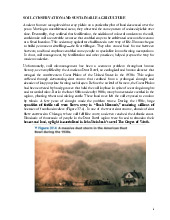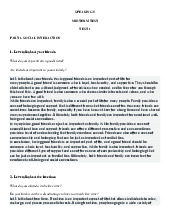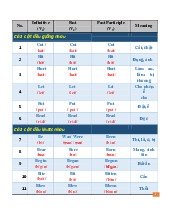



Preview text:
lOMoAR cPSD| 47270246 READING PASSAGE 2
You should spend about 20 minutes on Questions 14-26 which are based on Reading Passage 2 below. Driverless cars A
The automotive sector is well used to adapting to automation in manufacturing.
The implementation of robotic car manufacture from the 1970s onwards led to
significant cost savings and improvements in the reliability and flexibility of
vehicle mass production. A new challenge to vehicle production is now on the
horizon and, again, it comes from automation. However, this time it is not to do
with the manufacturing process, but with the vehicles themselves.
Research projects on vehicle automation are not new. Vehicles with limited
selfdriving capabilities have been around for more than 50 years, resulting in
significant contributions towards driver assistance systems. But since Google
announced in 2010 that it had been trialling self-driving cars on the streets of
California, progress in this field has quickly gathered pace. B
There are many reasons why technology is advancing so fast. One frequently cited
motive is safety; indeed, research at the UK’s Transport Research Laboratory has
demonstrated that more than 90 percent of road collisions involve human error as a
contributory factor, and it is the primary cause in the vast majority. Automation
may help to reduce the incidence of this.
Another aim is to free the time people spend driving for other purposes. If the
vehicle can do some or all of the driving, it may be possible to be productive, to
socialise or simply to relax while automation systems have responsibility for safe
control of the vehicle. If the vehicle can do the driving, those who are challenged
by existing mobility models – such as older or disabled travellers – may be able to
enjoy significantly greater travel autonomy. C
Beyond these direct benefits, we can consider the wider implications for transport
and society, and how manufacturing processes might need to respond as a result.
At present, the average car spends more than 90 percent of its life parked.
Automation means that initiatives for car-sharing become much more viable, lOMoAR cPSD| 47270246
particularly in urban areas with significant travel demand. If a significant
proportion of the population choose to use shared automated vehicles, mobility
demand can be met by far fewer vehicles. D
The Massachusetts Institute of Technology investigated automated mobility in
Singapore, finding that fewer than 30 percent of the vehicles currently used would
be required if fully automated car sharing could be implemented. If this is the case,
it might mean that we need to manufacture far fewer vehicles to meet demand.
However, the number of trips being taken would probably increase, partly because
empty vehicles would have to be moved from one customer to the next.
Modelling work by the University of Michigan Transportation Research Institute
suggests automated vehicles might reduce vehicle ownership by 43 percent, but
that vehicles’ average annual mileage double as a result. As a consequence, each
vehicle would be used more intensively, and might need replacing sooner. This
faster rate of turnover may mean that vehicle production will not necessarily decrease E
Automation may prompt other changes in vehicle manufacture. If we move to a
model where consumers are tending not to own a single vehicle but to purchase
access to a range of vehicle through a mobility provider, drivers will have the
freedom to select one that best suits their needs for a particular journey, rather than
making a compromise across all their requirements.
Since, for most of the time, most of the seats in most cars are unoccupied, this may
boost production of a smaller, more efficient range of vehicles that suit the needs of
individuals. Specialised vehicles may then be available for exceptional journeys,
such as going on a family camping trip or helping a son or daughter move to university. F
There are a number of hurdles to overcome in delivering automated vehicles to our
roads. These include the technical difficulties in ensuring that the vehicle works
reliably in the infinite range of traffic, weather and road situations it might
encounter; the regulatory challenges in understanding how liability and
enforcement might change when drivers are no longer essential for vehicle lOMoAR cPSD| 47270246
operation; and the societal changes that may be required for communities to trust
and accept automated vehicles as being a valuable part of the mobility landscape. G
It’s clear that there are many challenges that need to be addressed but, through
robust and targeted research, these can most probably be conquered within the next
10 years. Mobility will change in such potentially significant ways and in
association with so many other technological developments, such as telepresence
and virtual reality, that it is hard to make concrete predictions about the future.
However, one thing is certain: change is coming, and the need to be flexible in
response to this will be vital for those involved in manufacturing the vehicles that will deliver future mobility. Questions 14-18
Reading Passage 2 has seven paragraphs, A-G.
Which section contains the following information?
Write the correct letter, A-G, in boxes 14-18 on your answer sheet.
14 reference to the amount of time when a car is not in use C
15 mention of several advantages of driverless vehicles for individual road-users B
16 reference to the opportunity of choosing the most appropriate vehicle for each trip E
17 an estimate of how long it will take to overcome a number of problems G
18 a suggestion that the use of driverless cars may have no effect on the number of vehicles manufactured D
Ques 琀椀 ons 19-22 Complete the summary below.
Choose NO MORE THAN TWO WORDS from the passage for each answer.
Write your answers in boxes 19-22 on your answer sheet.
The impact of driverless cars
Figures from the Transport Research Laboratory indicate that most motor accidents are partly due to
19……………………., so the introduc 琀椀 on of driverless vehicles will result in greater safety. In addi 琀
椀 on to the direct bene 昀椀 ts of automa 琀椀 on, it may bring other advantages. For example, schemes lOMoAR cPSD| 47270246
for 20………………………. will be more workable, especially in towns and ci 琀椀 es, resul 琀椀 ng in fewer cars on the road.
According to the University of Michigan Transporta 琀椀 on Research Ins 琀椀 tute, there could be a 43
percent drop in 21…………………….. of cars. However, this would mean that the yearly 22…………………….. of
each car would, on average, be twice as high as it currently is. this would lead to a higher turnover of
vehicles, and therefore no reduc 琀椀 on in automo 琀椀 ve manufacturing.
Ques 琀椀 ons 23 and 24
Choose TWO le 琀琀 ers, A-E.
Write the correct le 琀琀 ers in boxes 23 and 24 on your answer sheet.
Which TWO bene 昀椀 ts of automated vehicles does the writer men 琀椀 on?
A Car travellers could enjoy considerable cost savings.
B It would be easier to 昀椀 nd parking spaces in urban areas.
C Travellers could spend journeys doing something other than driving.
D People who 昀椀 nd driving physically di 昀케 cult could travel independently.
E A reduc 琀椀 on in the number of cars would mean a reduc 琀椀 on in pollu 琀椀 on.
Ques 琀椀 ons 25 and 26
Choose TWO le 琀琀 ers, A-E.
Write the correct le 琀琀 ers in boxes 25 and 26 on your answer sheet.
Which TWO challenges to automated vehicle development does the writer men 琀椀 on?
A making sure the general public has con 昀椀 dence in automated vehicles
B managing the pace of transi 琀椀 on from conven 琀椀 onal to automated vehicles
C deciding how to compensate professional drivers who become redundant
D se 琀 ng up the infrastructure to make roads suitable for automated vehicles
E ge 琀 ng automated vehicles to adapt to various di 昀昀 erent driving condi 琀椀 ons




